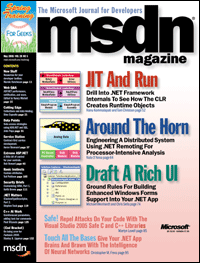 May 2005
May 2005
JIT and Run: Drill Into .NET Framework Internals to See How the CLR Creates Runtime Objects
There's lots to explore in the .NET Framework 2.0, and plenty of digging to be done. If you want to get your hands dirty and learn some of the internals that will carry you through the next few years, you've come to the right place. This article explores CLR internals, including object instance layout, method table layout, method dispatching, interface-based dispatching, and various data structures. Hanu Kommalapati and Tom Christian
Around the Horn: Engineer a Distributed System Using .NET Remoting for Process Intensive Analysis
Before the Microsoft .NET Framework, creating a distributed cluster of computers to perform scientific analysis was expensive in terms of hardware, programming and debugging time, and maintenance. You had to purchase expensive servers, spend time debugging network communication, design a distributed system completely different from a system deployed locally, and maintain a melting pot of error handling, data acquisition, networking, and analysis code. In this article, the author shows you how he was able to engineer a distributed computing system in C# to perform analysis of real-world data continuously acquired at high sampling rates, thanks to the .NET Framework. Nate D'Anna
Draft a Rich UI: Ground Rules for Building Enhanced Windows Forms Support into Your .NET App
In this article, the winning Windows Forms duo of Chris Sells and Michael Weinhardt team up again to explore lots of new features and additions to Windows Forms 2.0 that will let you build more flexible, feature-rich controls, get better resource management, more powerful data-binding abilities, and make your development life a whole lot more fun. Michael Weinhardt and Chris Sells
Safe!: Repel Attacks on Your Code with the Visual Studio 2005 Safe C and C++ Libraries
When Visual Studio 2005 ships, it will include a major upgrade to the Visual C++ Libraries that was the result of a complete security review of the functions contained in the C Runtime Library, Standard C++ Library, ATL, and MFC. From that extensive review came the Safe C and C++ Libraries, which can improve the security and robustness of your apps. Martyn Lovell
Touch All the Bases: Give Your .NET App Brains and Brawn with the Intelligence of Neural Networks
Pattern recognition is an increasingly complex field. Every day technologies like handwriting recognition, spam filters, and search engines must identify ever more complicated patterns. One way these complex relationships can be represented is through the use of neural networks. Find out what neural networks can do for your pattern recognition and prediction tasks. Christopher M. Frenz
Columns
| Editor's Note: Under the Covers and Through the Words
There are some people who have little curiosity about the world around them. They drive to work without asking why their airbag light is on. They work all day, never once wondering why their computer goes through periods where it's slow as a snail.
|
New Stuff: Resources for Your Developer Toolbox
Visual Build Professional 5. 6 by Kinook Software is a management solution for developers writing programs for Microsoft® Windows® and the Web that lets you create an automated, repeatable process for building your software. Marnie Hutcheson
|
Web Q&A: ASP.NET Performance, Notification, Keeping Sort Order, and More
Edited by Nancy Michell
|
| Cutting Edge: Collections and Data Binding
When it's time to design the Data Access Layer (DAL) of your distributed Microsoft® . NET Framework-based app, one of the key decisions you'll make is how you'll pass data to and from methods of DAL classes. Dino Esposito
|
Data Points: Data Access Strategies Using ADO.NET and SQL
When your goal is a scalable and efficient enterprise solution, you need to develop an efficient data-access strategy. You can't just do some testing on your production machines and rely on the results. John Papa
|
Service Station: Contract-First Service Development
In one of my previous columns on Service Orientation (SO), I introduced the concept of "contract-first" service development (see Service Station: SOA: More Integration, Less Renovation). Over the next two installments of this column, I'm going to cover the topic in depth. Aaron Skonnard
|
| Extreme ASP.NET: A Little Bit of Control for Your Controls
Having worked for so many years designing and developing ASP. NET while at Microsoft, it's exciting now to have a venue in which to talk about it. In this new column, Extreme ASP. NET, I'll discuss and demonstrate time-tested techniques and approaches to implementing high-performance, reliable, secure, and user-friendly Web applications with ASP. Rob Howard
|
Basic Instincts: Designing With Custom Attributes
One of the most powerful aspects of the Microsoft® . NET Framework is its support for attributes. Attribute-based programming is extremely powerful because it adds a declarative dimension to designing and writing software. Ted Pattison
|
Security Briefs: Customizing GINA, Part 1
Over the years I've had many people ask me to write about GINA, the Graphical Identification and Authentication component that serves as the gateway for interactive logons. This month I'll begin my coverage of this topic to help you get started if you're tasked to build such a beast. Keith Brown
|
| .NET Matters: ICustomTypeDescriptor, Part 2
In last month's . NET Matters column, I answered a question concerning the PropertyGrid control, specifically about using it with classes that expose fields instead of properties. I demonstrated how the ICustomTypeDescriptor interface in the Microsoft® . Stephen Toub
|
C++ at Work: Unreferenced Parameters, Adding Task Bar Commands, and More
Paul DiLascia
|
{End Bracket}: On Being Crew for Fantasia 2000
I was asked to reminisce about my experience as a software technical director on the Firebird segment of Disney's Fantasia 2000 in the special effects group. They're the group that puts the twinkle in Mickey's eyes, literally. Stanley B. Lippman
|

